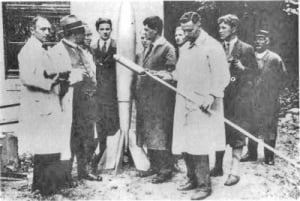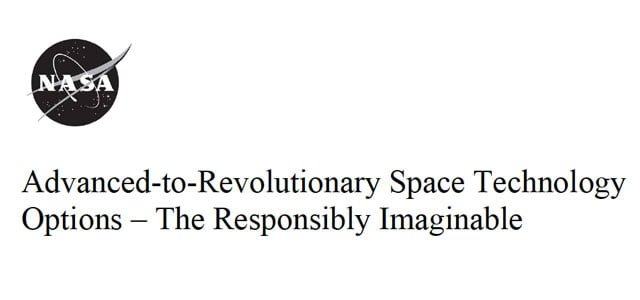Chief Scientist at NASA Langley Research Center Dr. Dennis Bushnell has authored a new report Advanced-to-Revolutionary Space Technology Options The Responsibly Imaginable which includes low-energy nuclear reactions (LENR).
This particular report focuses on how humans might visit Mars. “In general revolutionary goals [such as Mars-Humans] require revolutionary technology,” writes Bushnell, and LENR is part of NASA Langley’s portfolio of solutions.
In this case, “responsibly imaginable” means that “Nominal and usual enabling timescales for such technologies are the order of 12-to-15 years for research and triage, and another 12-15 years for development.”
 For humans to visit Mars, a large infrastructure must be launched from Earth orbit. This “up-mass” consists of all the elements to keep humans alive and safe, what NASA describes as “pink and warm”. Long-term space exploration has so far been powered by radioisotope generators (RTGs), which use radioactive plutonium to make heat that is turned into electricity using thermoelectric converters. Plutonium, aside from being dangerous and dirty, is in short supply these days, and recent Mars robotic rover missions have utilized most of the last store of material.
For humans to visit Mars, a large infrastructure must be launched from Earth orbit. This “up-mass” consists of all the elements to keep humans alive and safe, what NASA describes as “pink and warm”. Long-term space exploration has so far been powered by radioisotope generators (RTGs), which use radioactive plutonium to make heat that is turned into electricity using thermoelectric converters. Plutonium, aside from being dangerous and dirty, is in short supply these days, and recent Mars robotic rover missions have utilized most of the last store of material.
One thing about LENR, it can make heat. Dr. George Miley, Professor Emeritus at the University of Illinois Urbana-Champagne and head of start-up LENUCO, proposed replacing RTGs with LENR devices at the NETS conference a year ago, and has since speculated how these devices could power domestic needs as well.
Bushnell’s report also seeks to refute a statement made at a recent USAF workshop that claimed, according to Bushnell, “Space is a Mature and Declining field of Endeavour in the U.S.”
To do so, he first lists the experimental and commercial efforts with which NASA has been engaged over the decades to develop new useful technologies but that have not succeeded. Then he explains why, writing “Essentially, Space Commercialization going forward is hostage to far lower space access/launch costs.”

“We have, throughout the “Space Age” starting in the 1950’s, been in thrall to Chemical Propulsion. Breakthroughs in energetics and propulsion beyond Chemical appear to be required going forward.”
Fortunately, Bushnell believes that “The relatively straight forward applications of the ongoing civilian and military worldwide technology investments will greatly reduce mission cost and enhance safety going forward.”
Advances in materials science, information- and nano-technology have reduced the mass of spacecraft and thus the cost, but as Bushnell notes, “humans are not shrinking”, thus lower-cost lift, propulsion and power systems are required. That’s where LENR comes in, for high-thrust in-space propulsion.
“The LENR situation is in a major state of flux with recent apparently successful theoretical efforts and indications of much higher yields,” writes Bushnell, adding “if proven technologically viable, (LENR) would also be candidates for in space and on planet power.”
While the report inventories an array of possible technologies, here’s the portion devoted to LENR:
“Low Energy Nuclear Reactions, the Realism and the Outlook
LENR could, by itself, COMPLETELY Revolutionize Space access and utilization. Although there is a quite long history of “anomalous” observations including transmutations the “recent” consideration of Low Energy Nuclear Reactions begins with the Pons/ Fleishman late 80’s observations and assertions regarding what they termed “Cold Fusion”. Subsequent difficulties with experimental replication and an utter lack of convincing theoretical explication forced research in this arena “underground” with minimal financial support.”
“The current situation is that we now have over two decades of hundreds of experiments indicating heat and transmutations with minimal radiation and low energy input. By any rational measure this evidence indicates something real is occurring.”
“So, is LENR “Real”? Evidently, from the now long standing and diverse experimental evidence – yes – With effects occurring using diverse materials, methods of energy addition etc. This is FAR from a “Narrow Band”/episodic set of physical phenomena.”
“The next consideration is “WHAT IS REAL? WHAT IS Happening? For NASA Langley the epiphany moment on LENR was the publication of the Widom-Larsen weak interaction LENR Theory. This theory is currently under study and experimental verification [or not] at NASA LaRC. The theory appears to explain nearly all the various and often variegated experimental observations and shifted the LENR Theoretical focus from some way of “fooling” Particle Nuclear Physics/The Strong Force to Condensed Matter Nuclear Physics, Collective Effects, The Weak Force and “Heavy Electrons”. The Strong Force Particle Physicists have of course evidently been correct all along, “Cold Fusion” is not possible. HOWEVER, via collective effects/condensed matter quantum nuclear physics LENR is allowable without any “Miracles”. The theory states that once load surfaces with hydrogen/protons and add some energy IF the surface morphology enables high localized voltage gradients then “heavy electrons leading to ultra low energy neutrons will form, neutrons that never leave the surface. The neutrons set up isotope cascades that results in beta decay and heat and transmutations with the heavy electrons converting the gamma from the beta decay into heat.”
“The theory indicates several key issues/circumstances are required to enable-to-optimize
LENR and explains the various experimental observations, including the often long initiation times required in some experiments. If the theory is experimentally validated in detail it provides the understanding to shift LENR research from discovery into engineering development. The theory indicates energy densities some million times chemical, the current experiments are in the 10’s to hundreds range. However, several labs have blown up studying LENR and windows have melted, indicating when the conditions are “right” prodigious amounts of energy can be released/produced. There are some 6 or so groups claiming device outputs in the 100 watt range and 3 others claiming kilowatts. Efforts are ongoing within NASA and other organizations to validate, or not, these claims. It should be noted that these devices are essentially “Edisonian,” the result of attempts at experimental “discovery” vice ab-initio design from the weak interaction theories per se.”
“The LENR situation and outlook is therefore the following: Something real is happening,
the weak interaction theories suggest what the physics might be, there are efforts ongoing to explore the validity of the theories, there are continuing Edisonian efforts to produce “devices,” mainly for heat or in some cases Transmutations. There are efforts to “certify” such devices. We are still FAR from the theoretical limits of the weak interaction physics and are in fact inventing in real time the requisite Engineering, along with verifying the physics. When we concentrated upon Nuclear Engineering beginning in the 1940’s we went, “jumped” to the strong force/particle physics and leapt over the weak force, condensed matter nuclear physics. We are going “back” now to study and hopefully develop this arena.”
“The “Precautionary Principle” demands that we core down and determine realism for this arena, given the truly massive-to-mind boggling benefits – Solutions to climate, energy and the limitations that restrict the NASA Mission areas, all of them. The KEY to Space Exploration is Energetics. Some examples of what LENR might/ could enable in a resultant “Energy Rich” Exploration context include:
– Refrigeration for Zero Boiloff cryo storage
– Active Radiation protection
– High Thrust Vasimir/MHD Propulsion
– Energy Beaming
– Separation of propulsive mass and energy/ energetics to establish the requisite
conductivity for most “harvested” propulsive mass including regolith
– Planetary Terraforming
– Ubiquitous in space and on-planet sensors and robotics
– LEO propulsion
– On planet power and energy
– EDL retro via heating of ingested mass”
“Also, The Key to SST’s and neighbor-friendly personal fly/drive air vehicles is Energetics, as simplex examples of the potential implications of this area of research. There are estimates using just the performance of some of the devices under study that one percent of the nickel mined on the planet each year could produce the world’s energy requirements at the order of 25 percent the cost of coal. No promises but something[s] seriously “strange” are going on, which we may be closer to understanding and if we can optimize/engineer such the world changes. Worldwide, worth far more resources than are currently being devoted to this research arena. Need to core down and determine “Truth”. If useful, need to engineer/apply.” —Dr. Dennis Bushnell Advanced-to-Revolutionary Space Technology Options The Responsibly Imaginable
They won’t call it cold fusion, but NASA is keeping an open-mind to new energy technology through experimentation and testing a LENR theory. Bushnell knows the importance of “not picking the winner” too early on. It isn’t easy, even for a national Chief Scientist.
In the report, Bushnell quotes Ivan Bekey from his Chapter 9 Long Term Outlook for Commercial Space in the book “Toward a Theory of Space Power”:
“The Nation’s space programs are in a horrible mess and appear to be locked in a
downward spiral. Almost all defense and civil government space programs suffer from
similar symptoms:
no toleration of or planning for failures
avoidance of risk
lack of funding for new technologies
inability of industry to afford research or to develop technologies alone
suppression of disruptive technologies
disappearance of the concept of experimental systems in space.
As a result of these symptoms, the following conditions are now the norm:
absence of innovation
long timelines for even modestly new developments
billion-dollar price tags for major systems
major overruns and schedule slips
need for long on-orbit life to amortize the investment
obsolescence of systems upon launch or soon thereafter.”
Bushnell sums it up with:
“Overall – As mentioned in the Bekey comments cited herein, the pursuit of Revolutionary Space Technologies has over the years been akin to a battle, with the forces of conservatism/evolution consistently winning over those advocating risky/huge payoff REAL “Game-Changing” approaches. The Space Community has simply been unwilling to make the investment of time and treasure to ideate and triage/develop Revolutionary Technologies, resulting in Space being largely and still a high capital investment evolutionary at best Industrial Age Endeavour in the IT age heading rapidly to the Virtual Age.”
and ends with this quote of Ivan Bekey:
“The battle is within. It is a cultural one: between glorifying the past or
marching toward the future, between protecting successes or cannibalizing them,
between averting risk or embracing it. The battle is for the soul of the of the Industry [and the Future of Humankind in Space]”
… and we’ll add ‘on Earth too’!
Cold Fusion Now!
Related Links
Review of NASA/Zawodny US Patent application David J. French
Aneutronic Fusion Spacecraft Architecture – LENR Cold Fusion Gregory Goble
NASA LENR series Gregory Goble


Good news, yet not far from the article that get around the world few month ago…
anyway I feel that gov agency will never catchup…
Elon Musk will get to Mars alone.
Alain, I agree. NASA need LENR to get to Mars – or anywhere!
http://www.buildtheenterprise.org/
To explore strange new worlds
To seek out new life and new civilizations
To boldly go where no man has gone before
If all NASA can do is send a toy truck to Mars which apparently is only capable of sending back pretty pictures of itself but costs billions, then there is very little hope for those on the Earth needing Cold Fusion etc.
Private commercial space efforts are closing in fast, albeit in near-Earth/sub-orbital ventures. But it is not much more to putting private craft en-route to other worlds. I imagine private projects will succeed in that, too, IF they have a new source of power.
NASA should stick to the basic research for long-term space missions and their LENR research is in that track. That is the new source of power that will accommodate NASA, private commercial space, AND our planetary societies.
At least they are the one agency in the federal U.S. that is publicly acknowledging the reality of the situation. I hope they can deliver.
The Responsibly Imaginable
To Possibly Be
Imaginable… Responsibly
Creatively See
Observational…The Reality
Hope of Theory
Occupational… Visionary
We Energize the Plea
Survival… Planetary
Space Faring
Quantum
LENRgy
gbgoble2013
FARING : intransitive verb
1. To get along
2. To go or happen
3. To travel; go.
4. To dine; eat.
Middle English faren, from Old English faran; akin to Old High German faran to go, Latin portare to carry, Greek peran to pass through, poros passage, journey
First Known Use: before 12th century